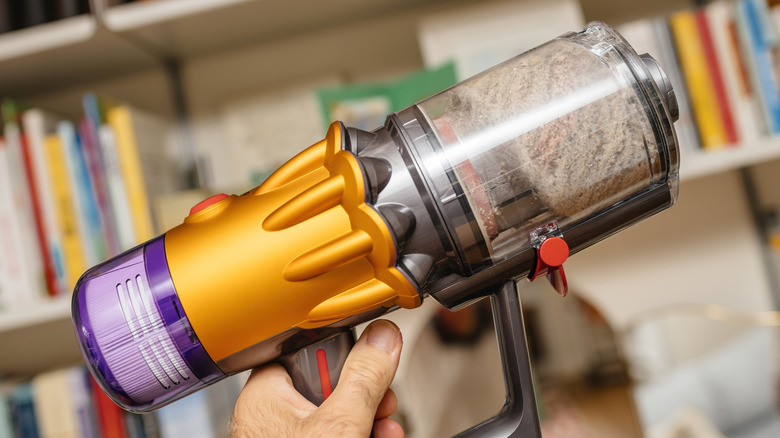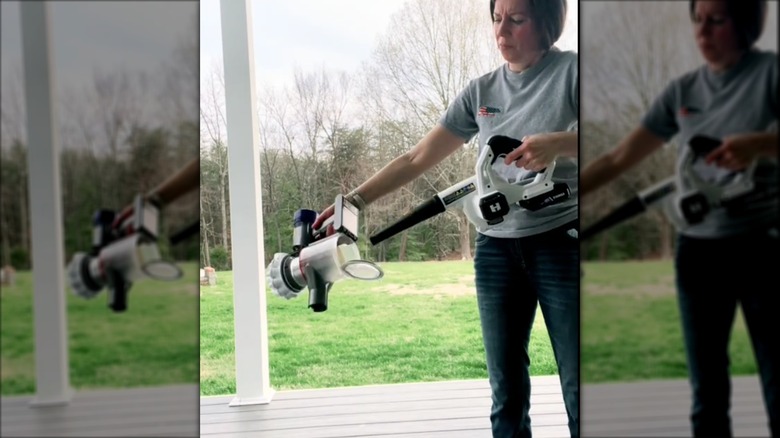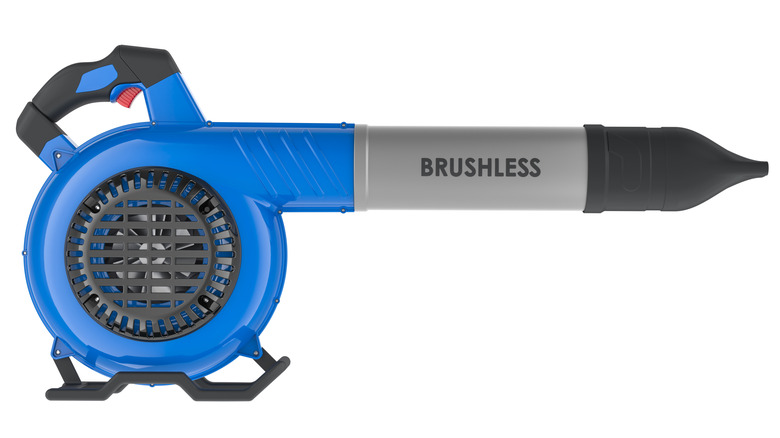The Unlikely Outdoor Tool That Makes Deep Cleaning Your Vacuum A Breeze
If your vacuum cleaner hasn't been cleaned in a while – a common mistake that can harm your vacuum cleaner — there's an easy way to fix that. It's no secret that this common household tool can get gummed up over time because of the dust, dirt, and other items it collects every time it is used. Once a vacuum cleaner becomes clogged, its performance degrades. This is why it is important to regularly clean a vacuum cleaner, and one effective and surprising way to do this is to use a leaf blower.
Though leaf blowers are primarily used for clearing leaves, grass clippings, and other light debris from lawns, gardens, and driveways, they can also clear out your vacuum cleaner. The strong stream of air produced by the leaf blower's electric motor and fan can clear out reusable vacuum bags, dust filters, fans, and vacuum heads. Of course, not all vacuum cleaners are the same, and for models that include disposable bags or disposable filters, it is best to replace those rather than to clean them.
The process of using a leaf blower to clean a vacuum is straightforward, but it is important to do it outdoors. This is to avoid making a mess with the dust and dirt that will be blown away by the leaf blower, and to remove the possibility of knocking over any decor or other items if done inside the house.
Quick and easy way to clean a vacuum cleaner
When cleaning a vacuum cleaner using a leaf blower, it is important to follow the same essential steps when cleaning it the conventional way to avoid damaging it or causing personal injury. To begin the process, the vacuum cleaner needs to be turned off and unplugged. Next, it needs to be disassembled by removing the parts, as these will be cleaned separately.
Once the hose and other attachments are detached, remove the bag, if the vacuum model has one, the lint trap, and filters. Next, empty the contents of the bag into a trash bag or directly into the garbage can and ready the leaf blower. First, use the leaf blower and clean the individual parts by holding them directly in front of the leaf blower nozzle, ensuring both sides are exposed to the air stream.
The next piece should be the dustbin, which, depending on the type of vacuum cleaner, either stick, corded, or upright, can be cleaned by placing it on the floor, or as seen in the image above, where a Dyson cordless stick vacuum is being held while the leaf blower blows away the accumulated dust and dirt. Once all parts have been cleaned by the leaf blower, reassemble the vacuum, and it's ready to be used again.
Cleaning a vacuum cleaner is important
The advantage of using a leaf blower to clean a vacuum cleaner compared to the traditional way of using soap and water is its simplicity and efficiency, as it can be done quickly with no additional materials needed. More importantly, a leaf blower removes the risk of damaging the electrical components of a vacuum because it is not exposed to water.
An important downside to consider when using a leaf blower to clean a vacuum cleaner is it cannot provide a thorough or detailed clean. This is because some grime or built-up dirt, and the small crevices or interior parts of the vacuum, cannot be cleaned by air alone. To do an intensive clean for a vacuum cleaner, it would be best to use soap, water, toothbrushes, and rags, as this method would ensure that all the parts, both internal and external, are given a good scrub.
The benefits of regularly and properly cleaning a vacuum are numerous, starting with better efficiency. With no clogs in the filter or dustbin, the vacuum can operate at its full capacity, and it eliminates the risk of overheating the motor, which can lead to potential damage, requiring parts or repairs. In addition, a clean vacuum cleaner minimizes potential health issues because molds or bacteria cannot grow, and will not recirculate dust and allergens previously collected. Lastly, by observing proper care and maintenance, which includes cleaning, the lifespan of a vacuum cleaner can be lengthened, reducing replacement costs in the long run.


